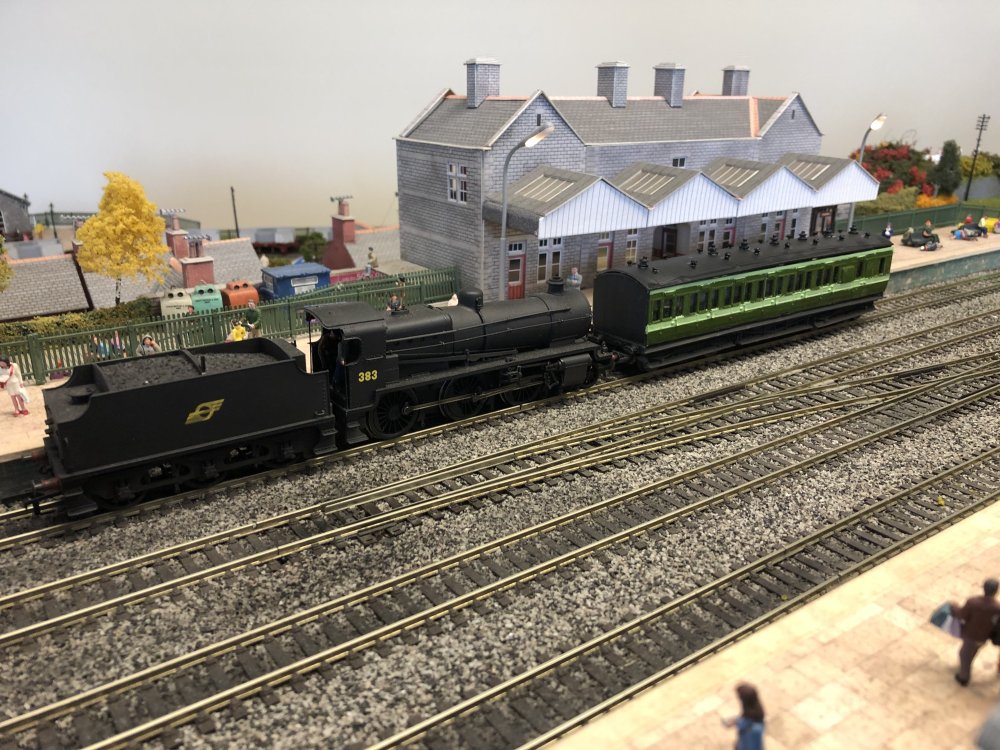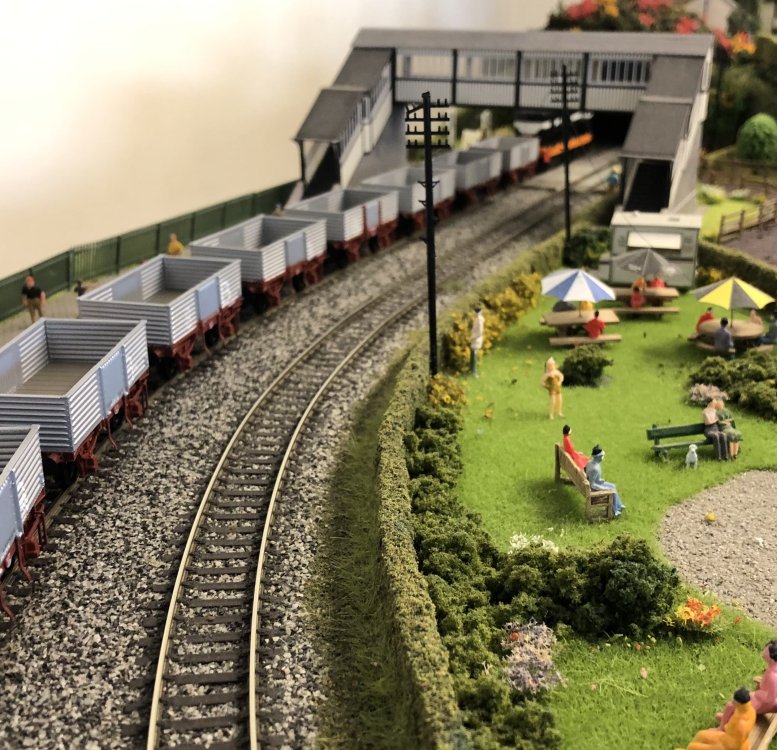-
Posts
15,873 -
Joined
-
Last visited
-
Days Won
393
Content Type
Profiles
Forums
Events
Gallery
Everything posted by jhb171achill
-
This is long overdue. For ALL freight trains prior to the late 60s, and most up to the late 70s, brake vans at the back are as essential as the loco at the front. And no matter what repaints or alterations we do, there's not a single British RTR van that looks even remotely like any that ran here ever. We've JM Design's excellent planked ones so far, and both GSWR / GSR and GNR types from Provincial Leslie, but an IRM RTR CIE one is badly needed! Several body design variations, several livery variations for different eras; bring 'em on....! Also in dire need of: Tin vans!
-
Production Complete - A First Look At Our Bulleid Open Wagons
jhb171achill replied to Warbonnet's topic in News
Correct, galvanised rather than painted. But chassis remained grey up to just the final years as in the model above. Anything in the modelling world based on real life before, say, 1985-90, will require purchase of the grey chassis ones. -
how much would it take to fix up the tralee to blenervile
jhb171achill replied to irishrailways52's topic in General Chat
I think the carriages are a long lost cause - I’d be more worried about the fate of the engine! -
I believe D&M are long defunct.
-
This is possibly posed; it is certainly not an actual train, as the carriages are of 1890s design. At that stage only three "singles" remained, and they were long gone from the main line - just shunted around Broadstone. In this view, if not posed, he's lifting an incoming up Galway / Sligo (two portions combined in Mullingar; Sligo part rearmost) out of the arrival platform.
-
Superpower on the branch local…and some of the new IRM Bullied opens in late 1980s / early 1990s sugar beet guise . The standard of these excellent wagons has to be seen to be believed… IMG_1057.mov
-
Irish Railway News ‘Enterprise Watch’
jhb171achill replied to IrishTrainScenes's topic in General Chat
....just running to catch the bus here............ -
A most unusual looking vehicle! It will look great when done...
-
Irish Railway News ‘Enterprise Watch’
jhb171achill replied to IrishTrainScenes's topic in General Chat
My understanding is that it will be ICRs. -
Received my Bullied opens today. They are absolutely stunning. The level of detail and overall realism is outstandingly good, as we would expect. Top marks, yet again, to IRM. I would snap these up if you want them, folks, as they're bound to be a top seller!
-
Irish Railway News ‘Enterprise Watch’
jhb171achill replied to IrishTrainScenes's topic in General Chat
Putting an oul crate like these things on the Enterprise service is just awful. I've made a note on the new Enterprise timetable of which services are railcar-operated, and will make sure I won't be using them. DDs only for me! -
To be fair, major work is being, or has been, undertaken in several important city termini - Galway, Limerick and Cork in particular, and more suburban stations are planned in Limerick and Cork areas.
-
Haulin' Oats! Grain Wagons Next For IRM's "Project Bulleid"
jhb171achill replied to Warbonnet's topic in News
Correct, yes. Or loaded from chutes to one side, under cover. -
At the very end, Waterford had the middle layout and Tramore was just a dead end….
-
Irish Railway News ‘Enterprise Watch’
jhb171achill replied to IrishTrainScenes's topic in General Chat
They need mobile phone sockets in them at the least. Last time I was on one they didn’t have it. This is as good as expected nowadays; same with the 29 class. -
Irish Railway News ‘Enterprise Watch’
jhb171achill replied to IrishTrainScenes's topic in General Chat
Do we know the paths for the CAF? Presumably it’ll be advertised as no 1st class or meals? I need to know what services to avoid! I’ll only use DDs. -
Excellent work as always1
-
“Yes, I know it’s DEAD… Barney threw stones at it and it didn’t move. But where did it COME from?’ ”It's that oul weedkiller, whatever they’ve put in it now, makin’ em all grow, or the myxomatosis or something….. ye think it bites?” ”I'm after tellin' ye it’s DEAD, ye thick. Any sign of the guards yet?”
-
On a typical day, there will probably be about 4 or 5 trains running. Mallow station is on a separate circuit - today that had the Executive train with a zebra-liveried 201. The two-car 26 is often on that too. The main circuit today had the NIR train shown, the 2-car 26, a grey 121 + bubbles, an "A" with cravens and a Mk 4 set (as shown). So five sets today - that's fairly typical - plus the 0 gauge overhead. There's a 29 class set now too, forgot to mention that one. I posted pics of it a while back. Nice repaint job.
-
Many thanks! There can be up to half a dozen or more trains operating at one time. Also present today was a 121 with cement bubbles, and an "A" hauling Cravens. On the upper !O" gauge track, a durty silver "C" class had a late 1950s train of cattle wagons...... In storage, among other things, are 201s in various liveries, 071s likewise, Mk 2s and Taras. With the new IRM announcements, hopefully we'll have some 4-wheeled stuff out'n'about soon! And, of course, eventually bring on the ICRs!
-
Irish Railway News ‘Enterprise Watch’
jhb171achill replied to IrishTrainScenes's topic in General Chat
A CAF??? They might as well use a 2600 as one of those. -
A "Woolwich" can be made up from one of the Southern Railway "N" class 2.6.0s - just remove the "blinkers" and drop it into a bucket of dark grey paint! (Or lined green after 1946). As far as a Dean Goods is concerned, if it is to fit into a Sligo scenario it has to be a loco of MGWR origin ideally, though obviously WLWR & GSWR types came in off the "Burma Road". The cab of a Dean goods is unlike most that the GSWR or MGWR had, but is not at all unlike WLWR cabs. A simple repaint will turn it into a very generic WLWR 0.6.0; it could, for the sake of argument, given a round-topped firebox and alterations to the front splashers, be turned into one of the two 235 class - but they were scrapped in 1927 & 1951. Alter its cab to a more GSWR-ish style - a simple job with plasticard - and it's good enough as a generic loco off the Burma Road - one of the many iterations of the J15 class. I have seen a picture of a MGWR J17 with a cab a bit like that. This would work, and would be arguably more suitable, as these would have been more typical in that area. The only "must" would be the removal of the brass GWR dome and to put the safety valves in the normal place instead of on top of the cab. All 0.6.0s would be plain grey up to the mid-1950s, some with flying snails, others not. Towards the last few years of steam, a small number of 0.6.0s were repainted plain black - again, some would acquire flying snails while others didn't.
-
Cork Suburban Upgrade
jhb171achill replied to Branchline121's topic in What's happening on the network?
If they make the Caark ones red and white, boy, thye'll need to make the Dub's ones two-tone blue! -
It’s 1992 and an (abridged!) Enterprise passes through Malahide. IMG_0985.mov
.png.c363cdf5c3fb7955cd92a55eb6dbbae0.png)








